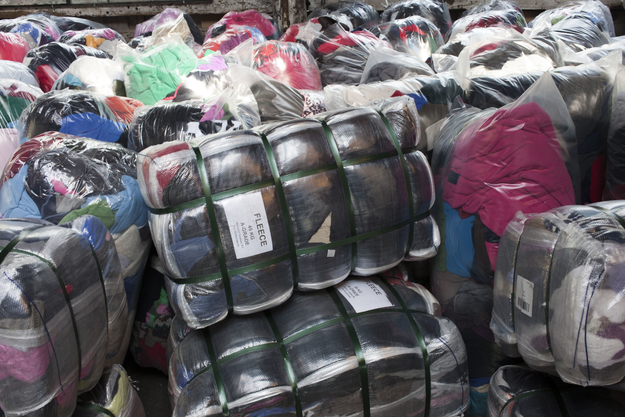1: Oil
When it comes to pollution, the clothing industry is second only to the oil industry.
Fleece is made from polyester, polyester is made from oil.
2: Fashion Machine
The title ‘Fashion Machine’ refers to the ‘fast fashion’ clothing industry’s insanely overactive production mechanism, as well as to the large number of volunteers needed to process 2,000 kilos of Amsterdam’s discarded fleece sweaters into enormous knitting-works.
3: Labor
Fashion Machine is a system of labor-intensive steps: sorting, cutting, washing, and knitting, which mirrors the intensive labor of producing our clothes in the clothing industry.
4: Mediamatic
This edition of Fashion Machine at Mediamatic (having started at Het Nieuwe Instituut in Rotterdam and subsequently shown in DordtYart in Dordrecht) focuses less on exhibition and more on action. The action of collecting, sorting, cutting and knitting the fleece sweaters, of including hundreds of volunteers and spreading the message about the clothing industry and microplastics.
5: Afterlife
This edition of Fashion Machine at Mediamatic focuses also on fleece’s ‘afterlife’. By experimenting with fungal cultures which transform fleece into a new, biodegradable, material, in cooperation with Officina Corpuscoli.
In addition, we are researching possibilities and scenarios for PET and fleece in cooperation with Mediamatic and the Laboratory for Critical Technics at Arizona State University.
6: 570m2
The goal of project Fashion Machine is to cover the Mediamatic building in 570 square meters of knitting-work made from Amsterdam’s discarded fleeces, in order to raise awareness of the problem of overproduction in the clothing industry and microplastics.
7: Garbage dumps
40% of all clothing produced worldwide ends up on garbage dumps.
8: PET
Fleece is made from polyester and since 1994 an increasing amount of fleece is made of recycled PET bottles. 25 PET liter bottles = 1 fleece sweater.
9: Ecospun
1993, Ecospun, a yarn from recycled PET bottles is introduced by Wellman in the USA. Patagonia is the first brand that releases a series of fleece items partly made from recycled PET.
10: Fleece
Production of fleece from recycled PET bottles offers no solution, it creates a new problem. Fleece being just another pollutant.
11: Solution
This project offers no solution, it raises awareness.
12: Microplastics
A fleece releases a million microplastics per washing, which reach the surface water via the sewers, the fish via the water, and our plates via the fish.
13: 34.8%
A third of all microplastics in water come from washing synthetic clothing, fleece being the main offender.
14: Toxic waste
Microplastics bind themselves to toxic waste materials such as solvents, pesticides, medicine, and drugs, which reach wastewater through the sewers. These toxic waste materials end up on our plates through the microplastics in the food chain.
15: Unwanted
Fleece is the clothing industry’s drain. It has a massive presence on the discarded clothing pile but is unwanted by the second-hand clothes importers of Africa and India because of the heat, and by local second-hand shops because it’s not a sexy fashion item.
16: 6,000 sweaters
We are processing 2,000 kilos of discarded Amsterdam’s fleeces, which equals roughly 6,000 sweaters. Enough to wrap the Mediamatic building.
17: 0.00082
2,000 kilos represent only a fraction (specifically, 0.00082%) of total textile waste in the Netherlands.
18: 62 times
As of July 24th, 2017, Noord-Holland’s Wieland Textile Collection Company stores enough discarded fleeces to wrap an additional 62 of Amsterdam’s art institutions this summer.
19: Conny Groenewegen
Was a Fashion major at Willem de Kooning Academy, received a Visual Arts degree and took a 3D Textiles Masterclass with Yoskhiki Hishinuma. She won the Mercedes Benz Dutch Fashion Award and was nominated for the Dutch Design Award. Currently, in addition to projects like Fashion Machine, and designing costumes for the dance film ‘Otherland’ (premiere in March 2018), she’s had her own line of sweaters and bombers under the name Electric Co, since 2015.
